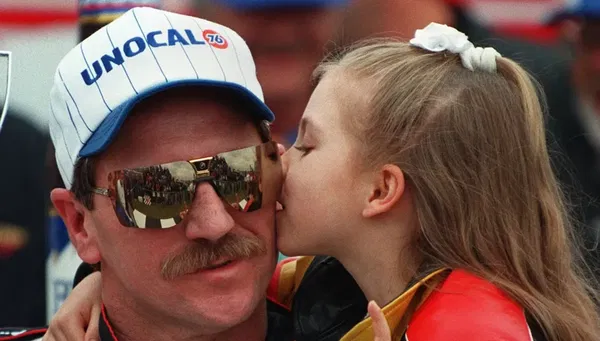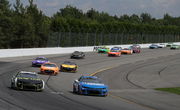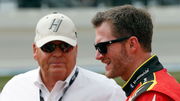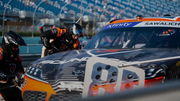

What if the greatest figure in NASCAR had unknowingly foreshadowed his fate? In the final months of his life, Dale Earnhardt spoke with the confidence of a man who had seen it all. He reflected on the changes in the sport he helped define, reminiscing about the days when stock cars could take a hit and keep charging forward. “We raced cars that were bullet-proof.”
Just hours before taking the track for the 2001 Daytona 500, Earnhardt gave his last interview, saying, “We’ve got a good shot at [it]. Got a good race car.” He acknowledged some reservations from the previous day’s practice but remained optimistic, adding, “I wasn’t excited about the car yesterday afternoon in the last practice, but the car, it’d come around, I think. It’s going to be okay. We’ve got a good engine in it.”
Sadly, Earnhardt’s car smashed into the retaining wall and other cars during the race’s last lap. Shortly after, Halifax Medical Center declared him dead, and it was found that a basilar skull fracture was the cause of death. His death prompted major safety changes in NASCAR, such as the requirement for head-and-neck restraints and the installation of SAFER barriers, which improved driver safety in the competition.
ADVERTISEMENT
Article continues below this ad
When toughness gave way to technology
As he reminisced about the durability of earlier NASCAR cars in March 2000, Dale Earnhardt, frustrated by the changes, unwittingly hinted at what was to come, and less than a year later, his words would take on a terrifying importance. Earnhardt prospered for the majority of his career at a time when speed was not as important as durability. His aggressive driving style was based on the belief that his car could withstand punishment, which he had developed during years of battling his way to the front.
However, NASCAR had changed its course by 2000. The cars were now more reliant on pure air, became more aerodynamic, and were more sensitive to contact. Earnhardt thought that was a concerning pattern. “If I raced an ‘86 Monte Carlo against a 2000 Monte Carlo. I could probably rough up that new Monte Carlo a little bit and beat him because I’d have him bent up a little bit, and I’d still be going straight,” he said in a news report with the Orlando Sentinel.
March 24, 2000: Dale Earnhardt said current Cup cars had become too delicate compared to old ones
“If I raced an ’86 Monte Carlo against a 2000 Monte Carlo, I could probably rough up that new Monte Carlo a little bit and beat him because I’d have him bent-up a little bit, and… pic.twitter.com/hSyzTdDNfS
— nascarman (@nascarman_rr) March 24, 2025
Earnhardt had long expressed disapproval of NASCAR’s move away from durability and towards speed and aerodynamics. He thought that harsher racing was made possible by the older cars, which were designed to endure greater collision. However, at the time, his worries were mainly ignored—just another veteran expressing his viewpoint.
What’s your perspective on:
Did NASCAR's obsession with speed cost us the legendary Dale Earnhardt? Share your thoughts.
Have an interesting take?
Earnhardt’s No. 3 Chevrolet made a brief contact with Sterling Marlin during the Daytona 500’s last turn on February 18, 2001, before crashing into Ken Schrader and the outside wall. At first, the collision didn’t seem catastrophic—there was no fire or violent flips—but the force of the hit and the car’s structural weaknesses made it deadly.
Earnhardt’s worries concerning the longevity of cars came to pass. On that awful day, NASCAR lost its biggest symbol as a result of its pursuit of speed. NASCAR had to take action after his death. Safer barriers were installed, the HANS device was made required, and a stronger chassis was incorporated in the Car of Tomorrow. Paradoxically, the safety modifications fixed the very problems Earnhardt had pointed out. It required catastrophe to set the sport straight after it had veered too far toward brittle, fast-moving machines. Although he never intended for his statements to be a warning, they were in retrospect.
Trending
ADVERTISEMENT
Article continues below this ad
How NASCAR ignored the warning signs before Earnhardt’s death
Earnhardt’s worries weren’t unique. In the late 1990s, NASCAR put aerodynamics and speed above durability. As cars became more dependent on clear air and more susceptible to small contact, Earnhardt, who was well-known for his aggressive racing, witnessed this problem personally.
There were warning indications. Similar crashes claimed the lives of Adam Petty and Kenny Irwin Jr. in 1999, both of whom suffered basilar skull fractures, as Earnhardt would. However, NASCAR opposed significant safety reforms, sticking with antiquated gear like lap belts rather than head-and-neck restraints. In addition to being a horrible accident, Earnhardt’s death was caused by NASCAR ignoring warnings.
There was silence in the garage when Dale Earnhardt’s car stopped at Daytona. Nobody realized how serious it was at first, but when NASCAR President Mike Helton said, “We’ve lost Dale Earnhardt,” the reality set in. The toughest driver in the sport was no longer there. The shock gave way to action in the days that followed. Overnight, drivers who had previously opposed safety precautions adopted them. The HANS device, which was previously optional, is now required. “We’ve all had wrecks just like that, but this one woke us up,” Rusty Wallace said.
ADVERTISEMENT
Article continues below this ad
NASCAR was obligated to act after Earnhardt’s passing. The sport was changed by stronger automobiles, safer obstacles, and stricter safety regulations. Despite the brutality of Ryan Newman’s 2020 Daytona collision and Michael McDowell’s 2008 Texas crash, the impact was evident. Even though Earnhardt didn’t live to witness the changes, he is responsible for every driver alive today.
ADVERTISEMENT
ADVERTISEMENT
ADVERTISEMENT
ADVERTISEMENT







Did NASCAR's obsession with speed cost us the legendary Dale Earnhardt? Share your thoughts.